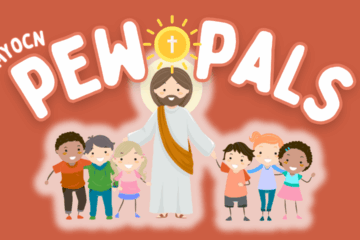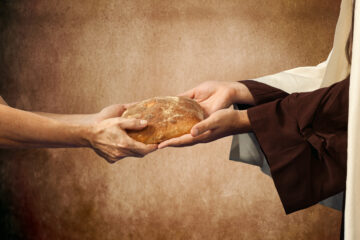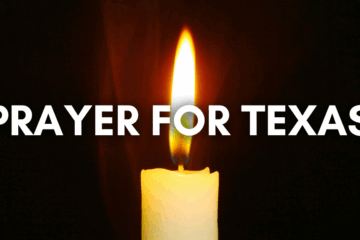The radiant earthly birthday of the Church, the Great Feast of Holy Pentecost, when we commemorate the descent of the Holy Spirit upon Jesus’s Apostles, 10 days following His Ascension to His Father in Heaven. It marks the fulfillment of Jesus’s promise to His disciples just before He ascended in glory to send the Paraclete, the Comforter, down to earth to abide with them. Symbolically, it is also the final culmination of the revelation of the worship of the Holy Trinity which began with the Feast of Theophany (Epiphany).
Background of the Feast
The Feast of Holy Pentecost (Πεντηκοστή, Pentekosti in Greek) is celebrated each year on the fiftieth day after the Great and Holy Feast of Pascha (Easter) and 10 days after the Feast of the Ascension of Christ, which itself always takes place 40 days after Pascha. The Feast is always celebrated on a Sunday. Just as all the Feasts of the Church have their typological, symbolic origin in the Old Testament, the feast of Pentecost was itself a vitally important feast observed by Jews marking, for them, 50 days after Passover, their Exodus from Egypt.
On the Jewish Pentecost, mentioned in Exodus 34:22, Jewish men from all over Judea and Israel were expected to attend services at the Jerusalem Temple in which they commemorated God granting the 10 Commandments to Prophet Moses on Mount Sinai. They also commemorated the first-fruits of the spring harvests in the Feast of Weeks, or Shavu’oth in Hebrew (שבועות), with the best grains and fruits being sacrificed to the Lord in the temple during the liturgies.
What thus marked the setting apart of the Hebrew people, the ancestors of the kingdoms of Judea and Israel, with the bestowal of the Mosaic law in the Old Testament, thus for Christians becomes the Feast of the New Covenant that establishes the Lord’s Church on earth through the preaching of the Apostles in all the tongues (languages) of the earth.
The importance of the Holy Spirit in the Church’s public, corporate prayer life, and all Her sacred liturgies, cannot be overestimated. So important was the sense of invoking the protection, grace, and aid of the Spirit that, in Late Antiquity and the High Middle Ages, from Constantinople to London, Russia to Spain, all over Christendom, the Church always invoked the Holy Spirit before the convening of important ecclesiastical councils, and in the coronation and anointing of kings and queens, emperors and empresses, including many saints of the Church.
Pentecost Mentioned in the Holy Bible
The story of the origins of the Christian Feast of Pentecost is found in the New Testament book of the Acts of the Apostles. In chapter two, we read that the Apostles of the Lord were gathered together in one place on the day of the Jewish Feast of Pentecost, lamenting His departure from them at His Ascension only 10 days earlier. The Scripture mentions how a sound, like a great, rushing wind, came from heaven, filling the entirety of the house. Tongues of fire appeared (another typological fulfilment of the Old Testament exodus of the Hebrews from Egypt, in which the God of Israel appeared by night as a pillar of fire, c.f. Exodus 13:21). The tongues of fire, the divine light, then sat upon each of the Apostles, who were filled with the grace and light of the Holy Spirit, speaking in all the languages of the world as directed by the Spirit (c.f. Acts 2:1-4).
Since the Jewish Feast of Pentecost or Shavu’oth was a great pilgrimage feast marking the offering of the first-fruits of the spring harvest (c.f. Exodus 34:22 and Deuteronomy 16:10), many people of all ethnicities and nations from throughout the Roman Empire were gathered in Jerusalem on this day. This included devout Jews, Gentile merchants, and Gentile men who worshiped the God of Israel as semi-Judaizing ‘theophiles’ or God-lovers, as they were known in Greek, the lingua franca of the Eastern Mediterranean at the time.
When the diverse peoples gathered in Jerusalem heard the sound of the Holy Spirit inspiring the Apostles’ to speak in tongues in the Upper Room, they came together and were astounded to hear their own languages being spoken by the Apostles (Acts 2:5-6). The people were amazed, knowing that some of those speaking were Galileans, provincial men from the rural, remote north of Israel, and not scholarly men who would normally speak many different languages. They wondered what this meant, and some even believed that the Apostles were drunk (Acts 2:7-13).
St. Peter, hearing these derisive remarks from Jews and Gentiles alike, stood up and addressed the crowd. He preached to the people regarding the Old Testament prophecies about the coming of the Holy Spirit, he testified about the Lord Jesus Christ and His death and glorious Resurrection. Thousands of the people gathered before him believed in his words, and they asked the Apostles, “What shall we do?” St Peter said to them, “Repent, and let every one of you be baptized in the name of Jesus Christ for the remission of sins; and you shall receive the gift of the Holy Spirit,” (Acts 2:38-39).
The Acts of the Apostles records that on that day alone, about 3,000 men, women, and children were baptized by the Apostles in Jerusalem. Following their baptism, the book of Acts notes that the newly baptized Christians—drawn from among Jews and Gentiles alike—continued to hear the teaching of the Apostles each day, as the early Christians met together for fellowship, the breaking of bread, and for common prayer—in other words, the earliest seeds of the liturgical, communal life of the Church. In these blessed days, the Apostles wrought many incredible miracles by the power of the Holy Spirit through the Lord’s name, and every day, more and more people came to believe in Christ. (Acts 2:42-47)
Icon of the Feast
The icon of the Feast of Holy Pentecost is known as “The Descent of the Holy Spirit”. At the top of the icon is a semicircle with rays coming from it. The rays are pointing outwards and down toward the Apostles, and the tongues of fire are seen descending upon each one of them, signifying the descent of the Holy Spirit and the grace of the Spirit which the Apostles received, as Jesus’s disciples, and which their successors, the bishops of the Church, hold today.
The building in the background of the icon represents the upper room where the Disciples of Christ gathered after the Ascension. The Apostles are shown seated in a semicircle, which is meant to indicate the unity of the Church in all matters of faith. Included in the group of the Apostles is Saint Paul, who, though not present with the others on the day of Pentecost, became an Apostle of the Church after his conversion, and went on to become Her greatest early missionary to the Gentiles. Also included are the four Evangelists, Matthew, Mark, Luke, and John, holding their respective books of the Gospel, while the other Apostles are holding scrolls that represent the holy teaching authority given to them by Christ.
In the center of the icon below the Apostles, a royal figure is seen against a dark background. This figure, Cosmos, symbolically represents the Gentile peoples of the world who had lived in the darkness and ignorance of pagan worship prior to Christ. However, the figure carries in his hands a cloth containing scrolls, which represent the Gentiles’ reception of the holy teaching of the Apostles. The tradition of the Church holds that the Apostles thus carried the message of the Gospel to all parts of the world, with St. Thomas—formerly “Doubting Thomas”—carrying the Gospel as fast east as southern India.
In the icon of Pentecost, we see the fulfillment of Christ’s promise of the Holy Spirit, sent down upon the Apostles, who will soon go out into the world to teach the nations and baptize them in the name of the Holy Trinity. We see here that the early Church was brought together and sustained in deep unity through the presence and work of the Holy Spirit, that the Spirit guides the Church in Her missionary work of spreading the Gospel throughout the world, and that the Spirit nurtures the Body of Christ on earth, the Church, in deep love.
Orthodox Liturgical Celebrations of the Feast of Pentecost
In the Orthodox Church and the Eastern rite Catholic Churches, this great Feast of the Church is celebrated with the Divine Liturgy of Saint John Chrysostom (c. 347-406). On the Saturday evening prior to the celebration of the Divine Liturgy of the Feast, Great Vespers is celebrated, and in the early morning before the Feast, Orthros (Matins), the morning service, is offered.
Traditionally, Eastern Christians adorn the inside of their churches on Pentecost with many living plants, flowers, and even trees, as is common in the Slavic Churches of Eastern Europe, to symbolize the revivifying, life-bestowing nature of the Holy Spirit coming down and into the world. The clergy wear bright green vestments, and to the usual altar coverings are added green ones. Additionally, for the first time since Pascha, the usual liturgical supplication “O Heavenly King” and the post-communion festal hymn “We have seen the True Light” are sung again in the Liturgy, calling the Holy Spirit to “come and abide in us” and proclaiming triumphantly after communing that “we have received the heavenly Spirit.”
Immediately following the conclusion of the Divine Liturgy in most parishes is celebrated what is called the Kneeling Vespers service, which include three lengthy prayers for the invocation and blessing of the Holy Spirit on the congregation and all the Church and world. To symbolize the catholicity of the Church—she is called to minister to all nations and peoples—these prayers are often read in multiple languages: Greek, Slavonic, Arabic, Georgian, and sometimes Hebrew, Russian, Ukrainian, Serbian, Romanian, etc. The faithful, clergy, choir, and laity alike, all kneel reverently and prostrate during these lengthy prayers, marking the first time in the Church’s liturgies since Pascha, the Feast of Jesus’s Resurrection, that the faithful kneel and prostrate in worship rather than stand in joyous honor of the Risen Lord.
Following Pentecost, in most Greek and some Slavic and Arabic Orthodox and Eastern Catholic Churches, the faithful once again kneel or make a full metanoia (low bow or prostration) at the Epiklesis, the “calling down” or invocation of the Holy Spirit during the consecration of the Holy Gifts of the bread and wine into Christ’s very own Body and Blood. The Monday following Pentecost is the Feast of the All-Holy, All-Good, and Life-Creating Holy Spirit, on which we commemorate and rejoice in our own hope of eternal glory with the Father, the Son, and the Holy Spirit.
Triumphant Hymns of the Great Feast
(often sung in multiple languages such as in this video)
“Blessed art Thou, O Christ our God, who hast revealed the fishermen as most wise by sending down upon them the Holy Spirit: through them Thou didst draw the world into Thy net. O Lover of Man, Glory to Thee!” (Troparion, tone 8).
“When the Most High came down and confused the tongues, he divided the nations. But when he distributed the tongues of fire, he called all to unity. Therefore, with one voice, we glorify the All-Holy Spirit!” (Kontakion, tone 8).
In addition to its vital place in the Orthodox Church, Pentecost is a hugely important feast in the Roman Catholic and Anglican Churches as well, with some of the most beloved hymns in these Christian traditions having to do with the Feast, such as the medieval Latin Gregorian chant Veni Creator Spiritus (“Come Holy Spirit”), or the Wesleyan hymn “O Thou Who Camest From Above” composed by Charles Wesley.



0 Comments